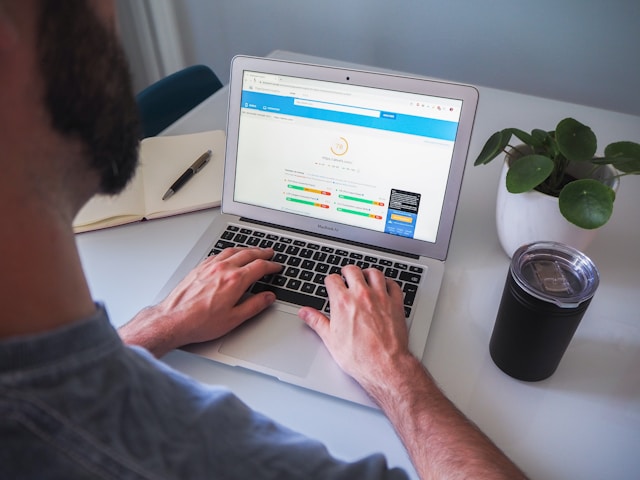Last Updated on July 8, 2025 by Richard Martin Linga
When it comes to improving your website, on-page optimization is where everything begins. This process makes your website more user-friendly and search-engine-friendly. It ensures your pages stand out, attract visitors, and perform better. In other words, it’s like upgrading your website to rank higher and gain more clicks. If you’re serious about growing your online presence, focusing on this is essential.
On-page optimization focuses on refining your website’s structure and content for better visibility online. It ensures each page is tailored to meet search engine requirements while offering users a seamless experience. By enhancing elements like keywords, headings, and images, it boosts both traffic and engagement effectively.
For extra support, an SEO specialist in the Philippines can assist you. They simplify the process by enhancing your content and fixing technical details. After that, you’ll see better rankings and more visitors engaging with your site.
What is On-Page Optimization?

On-page optimization means making your website better for both people and search engines. It’s like cleaning your room so it’s easy to find things. This includes using the right words, fixing headings, and making images load faster. In other words, it’s about improving everything on your site that you can control. This helps search engines understand your site and rank it higher.
Unlike off-page SEO, which deals with things like links from other sites, on-page optimization focuses on improving your own website. For instance, you can make your text clearer or add helpful links. Also, using SEO packages in the Philippines can help businesses make these changes effectively. Above all, it’s a simple way to make your website stand out and attract more visitors.
The Key Elements of On-Page Optimization
Here are the most important elements of on-page optimization that every website should focus on:
- Content Quality: Good content is the foundation of on-page optimization. It should provide value, use the right keywords, and be easy to read. For instance, high-quality content answers people’s questions clearly. Above all, content should be helpful and engaging to keep readers on your site longer.
- Title Tags & Meta Descriptions: These are the first things people see in search results. So, your title tags should be clear and include the main keyword. Meta descriptions should also explain what the page is about while encouraging clicks. In other words, these help improve your site’s click-through rate (CTR).
- Heading Tags (H1, H2, etc.): Headings make your content easy to read and organized. For instance, use H1 for the main title and H2 or H3 for smaller sections. Therefore, using proper headings helps both readers and search engines understand your page better.
- Internal Linking: Linking to other pages on your site helps visitors and search engines navigate easily. For instance, if you’re talking about SEO strategies, link to related pages to provide more value. In addition, linking helps spread page authority. Check out resources on link building in the Philippines for effective strategies. You can also buy permanent backlinks to boost your site’s authority and strengthen your on‑page SEO efforts.
- Image Optimization: Images make your site look better, but they can slow it down if not optimized. Use alt text to describe images so search engines can understand them. Also, compress image sizes to improve page speed. Above all, faster pages create a better user experience.
- URL Structure: Clean and simple URLs are important. For instance, use words that describe the page, like “/about-us” instead of long strings of numbers. In addition, descriptive URLs are easier for people and search engines to follow.
How to Optimize Your Content for On Page SEO

Here’s a simple step-by-step guide to improve your content for on-page optimization. Follow these steps to make your website rank higher and engage more readers.
Conduct Thorough Keyword Research
Find the best keywords your audience searches for. Use tools to discover terms people use. Also, pick keywords that match your topic, like SEO on-page optimization.
- Find Relevant Keywords: Choose words your audience uses.
- Focus on User Intent: Know what people want when they search.
- Use Long-Tail Keywords: Target specific phrases for better results.
Write Engaging Meta Titles and Descriptions
Your titles and descriptions are the first things people see. Write clear, catchy titles that include your target keyword. In other words, they should make readers curious and want to click.
- Keep Titles Short: Use 50-60 characters.
- Add Keywords in Descriptions: Make them helpful and to the point.
- Focus on Action Words: Encourage clicks with words like “Learn” or “Discover.”
Use Keywords Naturally in Your Content
Add the main keyword in the first 100 words. Sprinkle it throughout the content, so it feels natural and helpful.
- Avoid Keyword Stuffing: Don’t overuse keywords.
- Place Keywords in Headings: It helps with readability.
- Keep Sentences Short: This improves clarity and flow.
Optimize Images with Alt Text
Add alt text to describe your images. For instance, if you have a picture of a laptop, write, “Laptop for on-page optimization.” This helps search engines understand your images.
- Compress Image Sizes: Speed up your page load time.
- Use Descriptive Names: Rename files with keywords.
- Test Load Speeds: Ensure fast performance.
Improve Page Speed and Mobile-Friendliness
Fast pages and mobile-friendly designs improve user experience. Above all, search engines reward sites that load quickly and work well on phones.
- Use a Responsive Design: Make your site look great on all devices.
- Minimize Plugins: Reduce things that slow down your site.
- Work with Experts: Consider SEO services in the Philippines to optimize performance.
Common Mistakes to Avoid in On-Page Optimization

Avoiding common mistakes in on-page optimization can help improve your website’s rankings and user experience. Here are the most frequent errors and how to fix them.
1. Keyword Stuffing
Using too many keywords in your content can hurt your rankings. For instance, repeating “on-page optimization” too often makes your content look unnatural. Instead, use keywords sparingly and focus on writing for your readers.
- How to Fix It:
- Add keywords naturally in sentences.
- Focus on helpful content, not just keywords.
2. Duplicate Content
Copying content from other pages confuses search engines. They don’t know which page to rank, so your website may lose visibility. Above all, aim for original content.
- How to Fix It:
- Write unique content for each page.
- Use tools to check for duplicates.
3. Neglecting Mobile Optimization
Many people browse websites on their phones. If your site doesn’t work well on mobile, visitors leave quickly. Therefore, a responsive design is crucial.
- How to Fix It:
- Test your site on different devices.
- Use tools to improve mobile speed.
4. Ignoring Meta Tags
Meta titles and descriptions help search engines and users understand your page. Ignoring them is a missed opportunity to improve clicks.
- How to Fix It:
- Write clear, engaging meta titles.
- Include your main keyword in the description.
5. Not Using Internal Links
Skipping internal links can confuse visitors and search engines. In other words, linking related pages helps users find more information. For instance, use link building strategies to connect pages.
- How to Fix It:
- Add links to helpful pages on your site.
- Ensure links feel natural in the content.
Best Practices for Effective On-Page Optimization

Understand and Focus on User Intent
To make your website effective, always think about what users want when they visit your page. This is called user intent. For instance, if someone searches for “how to bake a cake,” they likely want a simple recipe. So, create content that answers their questions clearly and quickly. In other words, focus on being helpful instead of just trying to rank higher.
Ensure Your Site is Fast and Mobile-Friendly
Nobody likes waiting for slow pages, and search engines favor websites that load quickly. Also, check how your site performs on mobile devices. After that, make sure it looks great and works smoothly on any screen. Above all, a fast and responsive website improves user experience and rankings.
Use SEO Tools for Better Results
Tools like Yoast SEO can help you optimize your content. They assist with keyword placement and check readability. For instance, these tools point out long sentences or missing SEO elements. Therefore, using these tools saves time and makes your on-page optimization stronger. When you buy SEO services, you gain access to expert support that ensures every page meets search engine standards.
Perform Regular Site Audits
Frequent audits ensure your site stays in great shape. Look for broken links, missing meta descriptions, or slow-loading pages. Fixing these issues helps search engines and visitors navigate your site better. If you need help, an SEO consultant in the Philippines can guide you through the process and offer expert advice.
Key Takeaway
Mastering on-page optimization is essential if you want your website to rank higher on search engines. It helps people find your site easily and improves their experience when they visit. For instance, using the right keywords, fast-loading pages, and helpful internal links make your site stand out. Above all, these strategies are the foundation of any successful SEO plan.
If you’re ready to take your website to the next level, learning these techniques is a great start. In addition, getting expert help can make the process easier. For personalized support, you can hire me to guide you through effective SEO strategies. Let’s work together to improve your rankings and reach your goals.
FAQs
1. What is on-page optimization?
On-page optimization is the process of improving your website’s content and structure to make it easier for search engines and people to understand. In other words, it helps your website rank higher and attract more visitors.
2. Why is on-page optimization important?
It helps your website become more user-friendly and search-engine-friendly. For instance, it improves your rankings, increases clicks, and makes your site easier to use.
3. How is on-page optimization different from off-page SEO?
On-page optimization focuses on things you can control on your website, like content and keywords. Off-page SEO, on the other hand, deals with actions outside your site, like backlinks.
4. What are the key elements of on-page optimization?
Some key elements include using quality content, optimizing title tags, using headings, adding internal links, and improving images. Also, making your URLs clean and simple helps a lot.
5. How can I use keywords effectively in on-page optimization?
Use keywords naturally in your content. Add them to titles, headings, and meta descriptions. Above all, avoid stuffing too many keywords into one page.
6. Why is mobile optimization important for on page SEO?
Many people use phones to browse the internet. If your site doesn’t work well on mobile, visitors might leave quickly. Therefore, making your site mobile-friendly is a must.
7. How do internal links help with on-page optimization?
Internal links guide visitors to other pages on your site. For instance, they help readers find related topics and improve navigation. They also help search engines understand your content better.
8. What are common mistakes in on-page optimization?
Some common mistakes include keyword stuffing, duplicate content, ignoring meta tags, and slow-loading pages. After that, not linking to other helpful pages can hurt your SEO.
9. How can tools like Yoast SEO help with on-page optimization?
Yoast SEO checks if you’re using keywords correctly, makes sure your content is easy to read, and points out missing elements. In other words, it’s like having a checklist for your website.
10. Should I get professional help with on-page optimization?
Yes, especially if you’re unsure where to start. For instance, an SEO consultant in the Philippines can make the process easier by handling technical details and improving your content. Above all, they’ll help you see better results faster.
